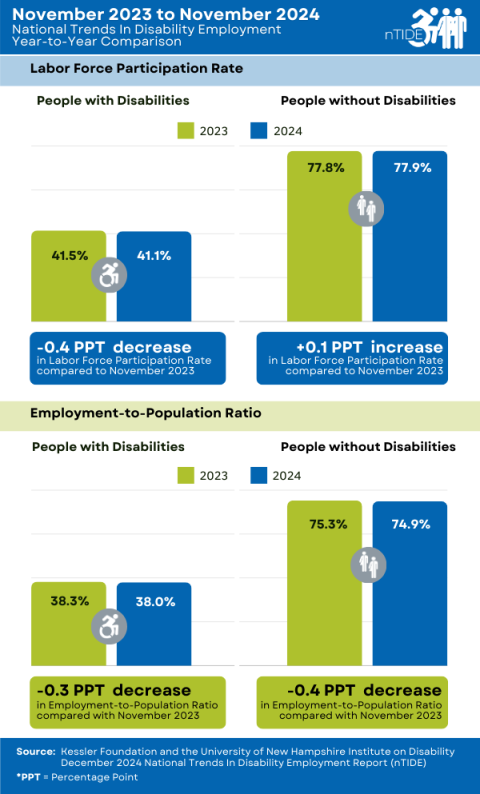
Join us for the next nTIDE Lunch & Learn Webinar featuring guest presenter Michael Fembek of the Zero Project.
nTIDE December 2024 Jobs Report: Employment for People with Disabilities Plateaus Near Record High
National Trends in Disability Employment (nTIDE) – Issued monthly by Kessler Foundation and the University of New Hampshire
Durham, NH – December 6, 2024 – Following significant gains since the post-pandemic lockdown, new data show a plateau in employment gains for people with disabilities, though still remaining near historic high levels. That’s according to today’s National Trends in Disability Employment monthly update (nTIDE) issued by Kessler Foundation and the University of New Hampshire’s Institute on Disability.
While the plateau reflects progress – particularly the narrowing of the employment gap between people with and without disabilities during periods of tight labor markets – experts suggest that the absence of new innovations or less widespread adoption of flexible practices may be hindering further growth. The return-to-office requirements, coupled with a lack of emerging workplace technologies akin to the “Zoom revolution,” are counterbalancing trends that could explain the inertia. Employers may now find it challenging to expand opportunities for people with disabilities without additional innovations or systemic changes.
“The employment-to-population ratio for people with disabilities plateaued in 2024, fluctuating between 38.3% and 36.5%. The increase in employment-to-population ratio for people with disabilities to 38.0 percent brings us very near the all-time high of 38.3 percent seen in November 2023 and May 2024,” remarked John O’Neill, PhD, director of the Center for Employment and Disability Research at the Foundation. “This stabilization in the employment rate may indicate that employers are facing challenges in maintaining the pace of innovation around accommodations seen during the COVID era. New advances in the workplace and work culture are needed to narrow the employment gap between people with and without disabilities.” Meanwhile, the employment-to-population ratio for people without disabilities remained flat, highlighting a plateau that has persisted since mid-2023.
Month-to-Month nTIDE Numbers
(comparing October 2024 to November 2024)
Based on data from the U.S. Bureau of Labor Statistics (BLS) Jobs Report released today, the employment-to-population ratio for people with disabilities (ages 16-64) increased from 37.0 percent in October 2024 to 38.0 percent in November 2024 (up 2.7 percent or 1 percentage point). For people without disabilities (ages 16-64), the employment-to-population ratio remained the same at 74.9 percent in October and November 2024. The employment-to-population ratio, a key indicator, reflects the percentage of people who are working relative to the total population (the number of people working divided by the number of people in the total population multiplied by 100).

The employment-to-population ratio for people with disabilities increased from 37.0 percent in October 2024 to 38.0 percent in November 2024; for people without disabilities the ratio remained the same. The labor force participation rate for people with disabilities increased from 40.4 percent in October 2024 to 41.1 percent in November 2024.
Meanwhile, the labor force participation rate for people with disabilities increased from 40.4 percent in October 2024 to 41.4 percent in November 2024 (up 1.7 percent or 0.7 percentage points). For people without disabilities, the labor force participation rate stayed at 77.9 percent in October 2024 and November 2024 (up 0 percent or 0 percentage points). The labor force participation rate is the percentage of the population that is working or actively looking for work (the number of people in the labor force divided by the number of people in the total population multiplied by 100).
“The labor force participation of people with disabilities has leveled off in the past year and a half,” said Andrew Houtenville, PhD, professor of economics and director of the UNH-IOD. “If the gains during the COVID and post-COVID periods were driven by remote and flexible work arrangements, a widespread return-to-office push could reverse this progress, leading to a decline from the current plateau,” he explained.
Year-to-Year nTIDE Numbers (comparing November 2023 to November 2024)
When compared to the same month last year, the employment-to-population ratio for people with disabilities decreased from 38.3 percent in November 2023 to 38.0 percent in November 2024 (down 0.8 percent or 0.3 percentage points). For people without disabilities, the employment-to-population ratio also decreased from 75.3 percent in November 2023 to 74.9 percent in November 2024 (down 0.5 percent or 0.4 percentage points).

The employment-to-population ratio for people with disabilities decreased slightly from 38.3 percent in November 2023 to 38.0 percent in November 2024. This ratio also decreased slightly for people without disabilities. The labor force participation rate for people with disabilities decreased slightly from 41.5 percent in November 2023 to 41.1 percent in November 2024, while this rate increased slightly for people without disabilities.
The labor force participation rate for people with disabilities decreased from 41.5 percent in November 2023 to 41.1 percent in November 2024 (down 1 percent or 0.4 percentage points). For people without disabilities, the labor force participation rate increased slightly from 77.8 percent in November 2023 to 77.9 percent in November 2024 (up 0.1 percent or 0.1 percentage points).
In November, among workers ages 16-64, the 6,697,000 workers with disabilities represented 4.5 percent of the total 15,0026,000 workers in the U.S.
Ask Questions about Disability and Employment
Each nTIDE release is followed by an nTIDE Lunch & Learn online webinar. This live broadcast, hosted via Zoom Webinar, offers attendees Q&A on the latest nTIDE findings, provides news, updates from the field, and features invited panelists who discuss current disability-related findings and events.
Visit the nTIDE archives at ResearchonDisability.org/nTIDE to view today’s nTIDE Lunch & Learn with experts Drs. John O’Neill and Andrew Houtenville and Denise Rozell, director of policy innovation at AUCD. Michael Fembek, CEO, of the Zero Project was guest speaker. Founded in Austria, the nonprofit’s mission is working towards a world with zero barriers. This is the last nTIDE Lunch & Learn for 2024.
Special Announcement:
Since the onset of the pandemic, our mid-month “COVID Update” series evolved into “Deeper Dive” sessions. In 2025, we are streamlining our approach to focus exclusively on “First Friday” episodes, complemented by select extended special editions.
